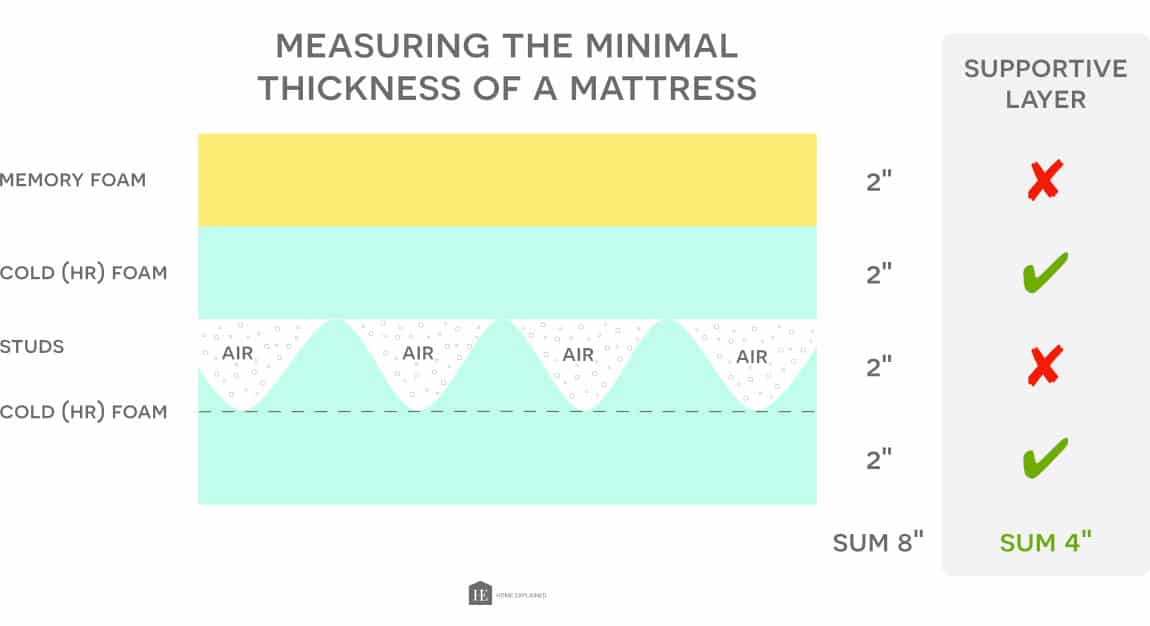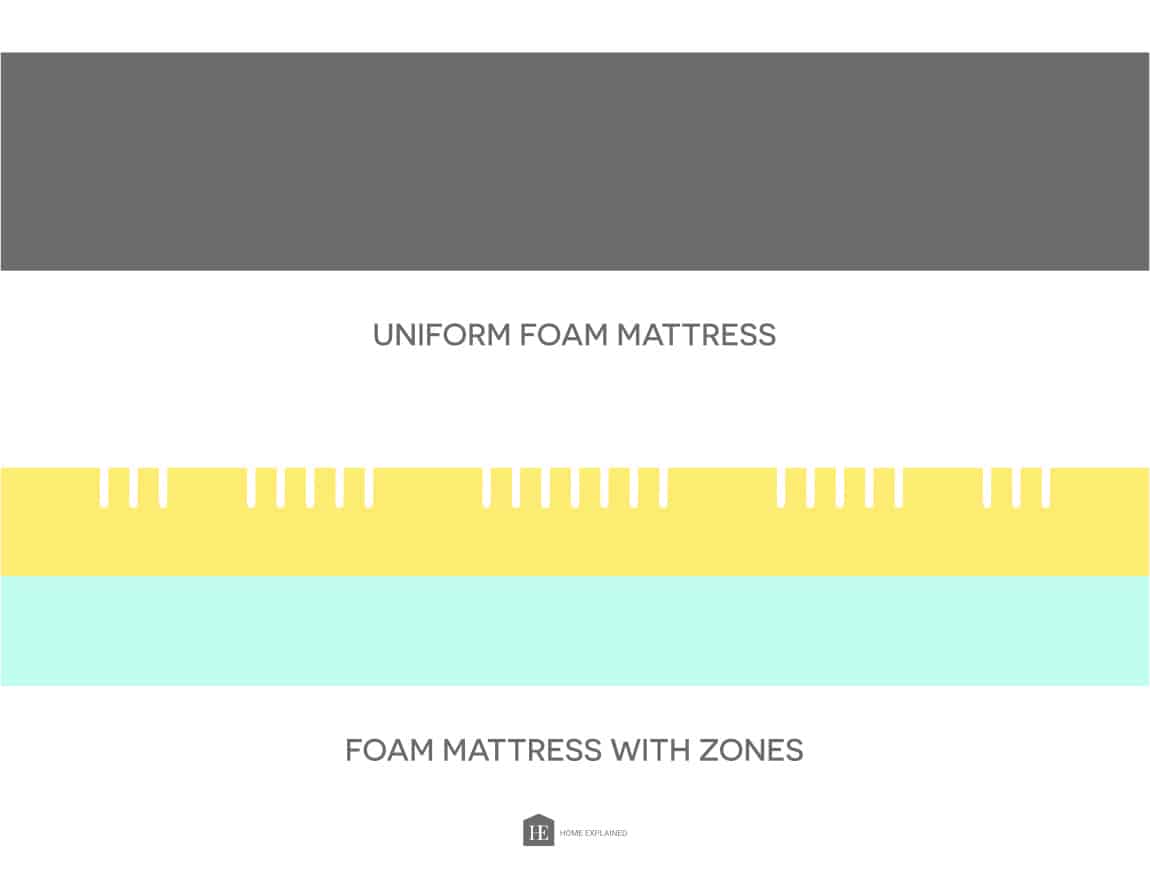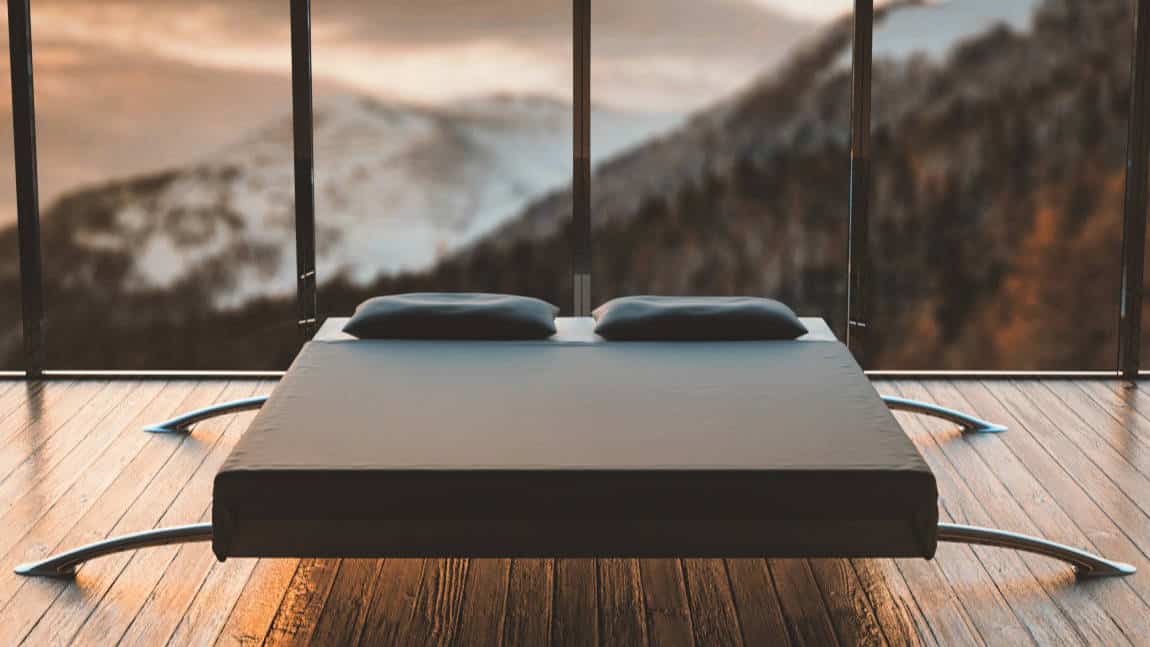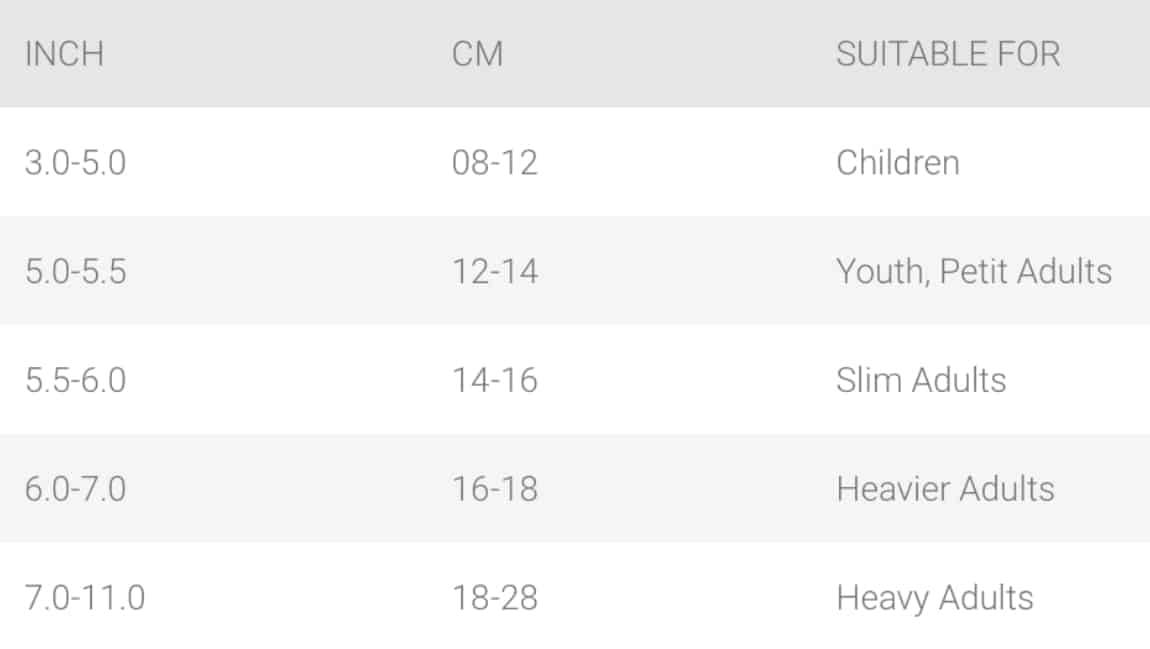When choosing a new mattress, it is tough to navigate between different types of mattress and countless adds that seem to advertise the best quality mattress. I know it because not so long ago we were choosing a new mattress ourselves. We have checked a store close to our home. The mattresses were comfortable, looked high-quality, had a 25-year warranty and to top it all of there was a big sale on them. We did some research, read many reviews and decided to buy them, however, shortly before the planned purchase we came across a video on YouTube, where a professional upholsterer and custom mattress maker explains how a high-quality mattress should look like. To my surprise, he was showing a mattress from the same brand that we have chosen – it was an overpriced, low-quality product that would probably sag after three years. Yayks. We have contacted him and received so many valuable information that I have decided to create a post about it. With this information, you should be able to recognize a high-quality mattress and spoiler alert; high price is not the main clue! He said that he had seen expensive mattresses, for ca $4,000, that were poor-quality!
Types of Mattresses
Let’s start with the basics. You can find three main types of mattresses:
- Foam mattresses (or memory foam mattresses)
- Spring mattresses
- Latex mattress (they can be made out of 100 % natural latex, 100 % synthetic latex or various ratios of natural and synthetic latex)
When choosing the type of a mattress, the odds are that your personal preferences will direct you to one or the other. Spring and foam mattress have a particular feel that some people might prefer. 100 % natural latex mattress might be appealing to someone who wants a natural product. However, it might be a no go for people with allergies or who live in a humid climate since latex can be prone to mold.
Note: If you are curious about the mold in mattresses, here is a link to a blog post which I have found, that discusses this topic).
Whichever type of mattress you choose, there are high and low-quality options. So let’s have a look at how can you distinguish a high-quality mattress and don’t end up with an overpriced one.
Determining Mattress Quality
When you try a new mattress, it might be comfortable, have a beautiful, luxurious cover, colorful cross-section with the latest materials with smart names, great warranty, and positive reviews. But how should you know what will happen with it after several years? Even though a mattress looks good at first sight, it might be just an advertisement trick. Fortunately, you can assess the quality of a mattress based on these parameters:
- Types of foam
- Density and Firmness
- Manufacturer
- Thickness
- Zones
- Washability
- The Bed Base
- Certifications
- Warranty
- Price
Foam mattresses (and also foam used in spring mattresses) are usually made out of polyurethane foam (PU), which belongs to the polymer family (plastic)[1]. You can find many types of PU foam with different characteristics, which make them suitable for different uses. If you came across a review, where they say that PU foam is cheap and doesn’t last long and that some other material is much better, be alarmed. If someone is talking about PU foam in general and says that it is cheap and low-quality material, it’s like showing a low-class car and saying that cars are cheap and have low horsepower. Off-course, it might apply to the car in front of them; however, there are other brands and models, that don’t match this description at all. The same logic applies to PU foam. Each type has different parameters hence different usage. Not every PU foam is suitable for long-lasting mattresses. To find out which foam to look for, you should know the type of the foam and its number, which describes the density and firmness of foam.
Types of Foam
Different types of PU foam are used for various purposes, e.g., kitchen sponges, packaging, soundproofing, furniture cushioning, etc. In the mattress industry, you can usually find four PU foam types:
- Rebonded foam
- Standard PU foam
- Cold (HR) foam
- Memory foam
Below you can find an overview of these foam types.
From what I have learned, the best quality foam you can have in a mattress is the cold (HR) foam. Its advantages come from a different manufacturing process. Its producing temperatures are lower than of the standard PU foam, hence the name cold foam. Thanks to that the cold foam has big open-cells with strong membranes, which has numerous advantages, like:
- air circulation – better breathability, which reduces sweating,
- higher durability – longer-lasting elasticity, thanks to which it keeps its original form for a long time,
- high resistance to compression (SAG factor) – high cushioning quality[2], it feels like it has springs in it, even though it does not. It’s thanks to big, uneven cells with strong membranes that act like small springs in the whole mattress.
Density and Firmness
Every PU foam has a four-digit number, which describes the density and firmness of foam. If you went to an upholsterer to buy a piece of foam, you would probably have to explain for what purposes do you need it, how often you will use it, etc., since various foams differ in their properties and also price points. Based on clients needs, an upholsterer chooses foam with a specific number that matches the given criteria.
Is this mattress durable?
If you know the number of mattress foam, you can have a pretty good idea not only of how firm it is but also if it is durable or not!

The first two digits = DENSITY = DURABILITY
The first two digits represent the density of the foam in kg/m3, meaning how much will a 1x1x1 m cube of particular foam weight. Density can also be stated in lbs/ft3 or pcf (pounds per cubic feet), determining how much will a 12x12x12″ cube of particular foam weight. The higher the density, the more material is used to produce it. That results in more durable foam. If you are buying a mattress, that you’ll use nearly every day, you should look for a density of 2,5 lbs/ft3 (40 kg/m3) and higher. This way, you are more likely to have a high-quality mattress that will last for a long time without uncomfortable indentations in the middle. That’s why density is one of the most important parameters of foam.
A rule of thumb regarding the density of standard and cold (HR) PU foam is:
- 30-38 kg/m3 for kids, light youth and light/small women
- > 40 kg/m3 for adults
Density x Price
The higher the density of the foam, the higher the price, since it takes more material to produce it. If you are buying a mattress, that will be used infrequently, e.g., in a cabin or a guest room, it is not necessary to look for high-density foam. Since it will be rarely fatigued, even lower density foam should be enough to last for a reasonably long time. Also, for a child or a very light person, it will be an unnecessary expense. On the other hand, if you are a heavy person, you should opt for a higher density, since even a 40 kg/m3 foam could sag earlier then expected under your weight.
Be aware that some manufacturers might advertise a mattress with cold high-density foam; however, it can be used just in a small percentage of the whole mattress. In this case, It will not be a high-quality, long-lasting mattress. The worst material in the mattress will be the first one to give in. That’s why if you want to buy a high-quality mattress for everyday use, it should be made out only of high-density foam. Or in case of a spring mattress, all foam parts should be made out of high-density foam.
HOW TO ESTIMATE THE DENSITY OF THE FOAM?
Since many companies don’t publish this information, there are ways to get an idea, if it could be a high-density foam mattress.
- Simply pick it up. A queen size bed 7″ high (18 cm) should weigh around 62 lb (28 kg)! Such mattresses are almost as heavy as latex mattresses. Below you can find an approximate mattress weight calculator which will help you to have an idea, how much should a specific mattress weight (king, queen, low, high, etc.).
- When you hold a high-density HR foam mattress it is flexible and elastic, it doesn’t feel stiff like polystyrene panel.
- When you open the mattress cover, and you will see, that:
– the corners of the foam are creased,
– the cover or the zipper is imprinted in the foam,
– the foam on the side is collapsed,
it means that the foam started to deform even under the pressure of the cover and clients. It indicates low-quality, low-density foam that will not last for long.- You can blow through the foam with your mouth and feel it on the other side HR high-density foam has high breathability.
- Quality HR foam is soft to touch. It feels like it is infused with gel, low-quality PU foam is dry, like dry skin on your hands or like emery paper.
How Much Does a Mattress Weight
The second two digits = IFD = FIRMNESS
The second two digits represent the indentation force deflection (IFD, previously known as ILD – indentation load deflection) of the foam. It is an amount of pressure in kPa needed to press the foam. The lower the IFD, the softer the foam, the higher the IFD, the harder the foam. This parameter should be chosen based on your weight (higher IFD for heavier people) and your personal preferences.
This parameter also determines, for which mattress layer is the foam suitable (ideally HR foam).
- Low IFD is suitable for the top layer, which works as a stress relief layer. It copies curves of your body and prevents bedsores.
- High IFD is ideal for lower, support layers to keep your body leveled and prevent bottoming out of the mattress.
Multiple firmnesses
Note, that one mattress can have multiple firmnesses. For example, a reversible mattress can have one side firmer than the other. The firmness can also be affected by the construction of the mattress. In some cases, a mattress can have zones, that change the firmness of just one section (e.g. under your arms, hips, etc.). For more information about zones keep reading, or click here. Below you can see a diagram of a mattress with four firmnesses, where the softest section is indicated by number 1 and the firmest by number 4.

Manufacturer
In this section, it is splitting hairs, but if you want to know a lot about foam, you should know, that two foam pieces with the same foam number made by two manufacturers can have different quality (e.g., breathability, durability, etc.). Two leading manufacturers of high-quality cold (HR) foams are:
- Carpenter Co.
- Greiner Foam International (Eurofoam in Europe, Unifoam in South Africa)
For example, Greiner Foam uses antioxidants against aging of the foam (foam stabilizers), which make the foam last longer. They also have Okotex certification (for more information, keep reading or click here).
If you will be able to find a mattress with foam from one of those manufacturers, you can expect to buy a high-quality product with excellent properties. Of course, it will be quite hard to find out this information, but if you will have the opportunity to choose a mattress based on that, Carpenter and Greiner are a great choice.
Thickness
The optimal thickness of a foam mattress is half of your bodies diameter. Depending on the way you sleep (on your back, side, or stomach), you should measure the widest part of your body. Also, the heavier the person, the thicker the mattress should be. But remember, the thicker the mattress, the more expensive it is since more material has to be used to produce it. Below you can find a general overview of what thickness of a mattress to look for based on a person weight.
Note: This overview applies to standard or cold (HR) high-density PU foam or latex mattresses. If you buy a lower-quality mattress with lower density, e.g., 1.2-2.4 lbs/ft3 (20-38 kg/m3), it is better to choose a thicker one. Spring mattresses have to be substantially thicker, for adults at least 9.5″ high (24 cm).
How to Measure the Thickness of a Mattress
The optimal thickness described above concerns only the supportive sections of the mattress. It is important to understand, which parts of the mattress should be measured to make sure that the mattress will be thick enough. Measure:
- without the cover – some covers can add even 2.5″ (6 cm),
- without the memory foam layer – it is only a stress relief layer, it does not support your body (it can be squished to almost 0″ if you stand on it),
- without high studs – some mattresses use them on the surface of the mattress to create a massaging effect and also to help with the airflow. Studs can also be used in the middle of the mattress to improve the airflow further. Be aware that such studs also help the manufacturer to lower their production costs since they can use less foam to produce thicker mattresses. A high stud has a very low supportive quality.
Note: Even thou studs seem like a great feature, people that suffer from bedsores, or had surgery might find them uncomfortable or straining. Especially if they are made out of standard PU foam.
Below you can see an illustration of how to measure supportive sections of the mattress.

Even though the mattress thickness is 8″, the relevant supportive layer has only 4″. The rest represents a layer for stress relief (the memory foam), a layer to improve the airflow or safe costs (studs) or for massage (if the studs are on the top of the mattress).
Zones
When you are looking at different mattresses, you might notice, that some are made out of a single piece of foam where other have sections with various perforations, rollers, incisions, etc. Those sections are often referred to as zones.

A uniform foam mattress is made out of a single piece of foam or multiple uniform layers of foam. It is a less expensive version of a mattress. Its downside is the fact that it won’t be able to adjust to your body as well as a mattress with zones. You might end up with spinal distortion, e.g., when lying on the side.
Zones represent separate sections that have various perforations, rollers, incisions, or softer materials, to help a mattress to adjust to your body shape. For example, if you are lying on your side, you should look for a mattress with softer zones in the shoulder and hip area, so that your spine can stay in level. Incisions and perforations can additionally help with the airflow. Note, that since zones represent additional work, it often means that the more zones, the more expensive the mattress is.
Washability
The thing that might be overlooked but is a great feature is the possibility to wash or sterilize a mattress and its cover. Especially if you have allergies to mites, etc. Let’s look at the mattress cover first.

The Cover
Look for covers that can be washed in at least 130°F (ca 50°C). It is the minimum temperature, to kill mites, that do occur in beds.
You can find covers that are hypoallergenic, antibacterial (e.g., with silver threads), etc. Those are great; however, If a cover has additional properties, the type of the cover should be embroidered on the fabric. If the vendor will tell you, that such cover has some additional features, but there is nothing embroidered on it, and you don’t get any attests proving it, it is questionable.
If you sweat at night, try to avoid 100 % Polyester, 100 % Cotton, or Cotton and Polyester mix materials.
Covers have different thicknesses. A sufficient weight of the material is ca 0.5 lbs (200-250g), a cover made out of heavier material can be so big that you might not be able to put it into your washing machine.
Look out for covers that have memory foam sawn into them. It is very unpractical since you won’t be able to wash it.
An excellent cover material that was recommended by the upholsterer is called Medicott Silver®.
The Foam Mattress
Some cold (HR) foams are durable to withstand steam up to 284°F (140°C). If you buy a mattress made solely from such foam (100 % of the mattress!), you can use a steamer, steam iron, or steam vacuum to sterilize the mattress, but of course without the covers. You will be able to sterilize it from mites, bacterias, and also, e.g., pee. However, don’t leave the iron or steamer to long on the foam, especially the steam iron, since if you run out of water, the surface of the iron could get hotter than 284°F and it could damage your mattress. Remember! You have to be sure that 100 % of materials in the mattress can withstand, e.g., 284°F, and that your steamer, steam iron or steam vacuum does not exceed 284°F. If not, you will damage your mattress!
Note: Foam and latex degrade partly because of the sun (UV radiation), high temperatures in the room, the temperature of the human body, and sweat. Thanks to the fact that cold (HR) foam can withstand 284°F (140°C), it can be expected that it will last longer than other types of foam.
The Bed Base
When buying a mattress, you might not think much about the bed base, but a good one can make a significant difference in the way you feel on the mattress and also how long will the mattress last.
If you want to learn how to choose a bed base, check out my other post, that is dedicated solely to this topic.
It is essential to understand that not every bed base is suitable for each mattress type. When choosing a mattress, you should take into consideration what type of bed base do you own, or you are planning to buy. In the table below, you can find a rule of thumb of how to combine bed bases and mattresses.
! Lowers the durability of the mattress
✓ Good Match
Certifications
Mattress certifications document harmlessness of the product. I would always prefer a certified mattress. In the case of foam mattresses, which are made out of polyurethane, it is good to make sure that it will not off-gass some harmful substances. There are two significant certificates:
STANDARD 100 by OEKO-TEX®
STANDARD 100 by OEKO-TEX® is probably the best certificate you can find. If a mattress has this certificate, it means that all parts of the product meet the set human-ecological requirements; hence, it also includes a mattress cover, threads, etc. This certificate has four product classes (I-IV) that differ in the strictness of the requirements. Classes are graded base on how close does the material get to the skin and also if it gets in contact with sensitive skin. The certificate for product class I is the strictest (for babies up to 3 years old). click here to see the official OEKO-TEX® website.
CertiPUR-US®
CertiPUR-US® is a certification that was created by PU foam manufacturers and applies only to PU foam. Even though OEKO-TEX® STANDARD 100 is a much better certificate, CertiPUR-US® is also a valuable one since it documents that various harmful substances are not present in the foam. If you are not able to buy a STANDARD 100 by OEKO-TEX® certified PU foam mattress, it is advisable to find one that has at least this certification. Click here to see the official CertiPUR-US® website.
Warranty
When we were looking for a mattress, we came across a good looking mattress that had a seemingly great 25-year warranty. That’s amazing, right? Be aware that such warranties are usually limited, subject to specific terms and conditions. For example:
- INDENTATION – warranties can cover possible indentations, which will likely occur sooner or later due to material deterioration. However, there are usually limit values, from which the warranty applies, e.g., 1.5″. It’s good to consider if you would like to lie on a mattress with 1.25″ indentation. Odds are that you would want to change it; however, it might not be covered by the, e.g., 10-year warranty. Below you can see a table with indentation limits of well-known mattress brands (as of May 10th, 2019).
| Company | Indentation Limit | Warranty |
| Tempur | More than 0.75″ | Official website |
| Tuft & Needle | More than 0.75″ | Official website |
| Casper | More than 1.00″ | Official website |
| Purple | More than 1.00″ | Official website |
| Leesa | More than 1.00″ | Official website |
| Nectar | More than 1.50″ | Official website |
| Puffy | More than 1.50″ | Official website |
- BED BASE – some companies lower the warranty, depending on the type of bed base you are using. For me, this is a sign of a decent company, which knows how a mattress works, that on a solid or fixed slatted bed base, the materials will give in faster.
- SPECIFIC PARTS – warranty might apply only to some parts of a mattress, e.g., in the case of spring mattresses you might find that a multiple-year warranty applies only to springs, the rest of the mattress is subject to standard 2-year warranty.
- ONLINE REGISTRATION – some companies give an extended warranty. However, to get it, you have to register your product online in, e.g., 30 days from the day of the purchase. Otherwise, such warranty will not apply.
- PARTICIPATION IN REPAIR COSTS – some companies transfer a specific percentage of repair costs to your account after a given time you have been using the mattress, e.g. after three years. The percentage can increases the longer you own the mattress.
Price
The price of a mattress should be the last parameter that you look at. Of course, I am not talking about ignoring the budget you have. What I mean is that it is not a rule of thumb, that a more expensive mattress is always a better mattress. The way you feel on it, and its parameters should be determining factors in choosing a mattress. As I have mentioned in the begging of this post, the upholsterer, that gave us so many useful information has seen expensive mattresses (for ca 4.000$) that were poor-quality. Some retailers sell mattresses from rebonded or PU low-density foam for high prices. If you see great discounts or 1+1 campaigns be alarmed. The retailer tries to earn money, so it’s unlikely, that he will lose 50 % of his margin. It seems that the mattress is not worth even half of its original price.
Now, let’s look at the last but not least thing that is important when choosing a mattress, namely how to test a mattress in a store.
How to Test a Mattress in the Store
The optimal way to test a mattress in a store is, of course, to lie on it. But consider what clothes are you going to wear. It’s best to dress in some soft, thin clothes, to simulate your pajamas. Tight jeans or sweaters are not ideal since you will not be able to feel the mattress well. If you will come to the store in cold weather, make sure to take off your coat, sweatshirt, etc., ideally take off your shoes too.
If you chose or own a solid (platform) or a fixed slatted bed base, you could ask the salesman if you can put the mattress on the floor. This will simulate, how will the mattress feel on such a bed base. In stores, mattresses are usually placed on a sprung slatted bed base, which can make the mattress feel different.
Try the mattress for a reasonably long time since it is hard to feel it out in just a couple of minutes.
Another good practice is to lie the way you usually sleep (on your back, side, or stomach). When lying on a mattress, your spine should look the same as you would be standing up, it should be straight. No crouched shoulder etc.
Also, look inside the cover. When you open it, the foam should spring right up; it should not stay crumpled, creased, you should not see the cover or the zipper imprinted in the foam. If it is the case, you can not expect the foam to last long, since it has deteriorated already in the store.
And last but not least. Don’t buy a mattress based on your friends’ recommendation or reviews. People have different body types, weight, sleeping style (back, side, stomach), bed base, etc. Even if your friends love a specific mattress, it doesn’t mean that it will suit you.
References
[1] EUROPUR AISBL. “WHAT IS POLYURETHANE FOAM?”. www.europur.org. Link to the site
[2] Quality Foam Packaging, Inc. “Polyurethane Glossary”. www.qualityfoam.com. Link to the site








Thank you for mentioning the importance of finding a polyurethane mattress that is known to last for a long time in order to ensure that it will not eventually deteriorate after a while. My wife and I are thinking about getting a mattress before we retire next year, but we need to find one that will support my weight since I am larger than most people my age. I’ll consider finding a mattress that will suit our needs.